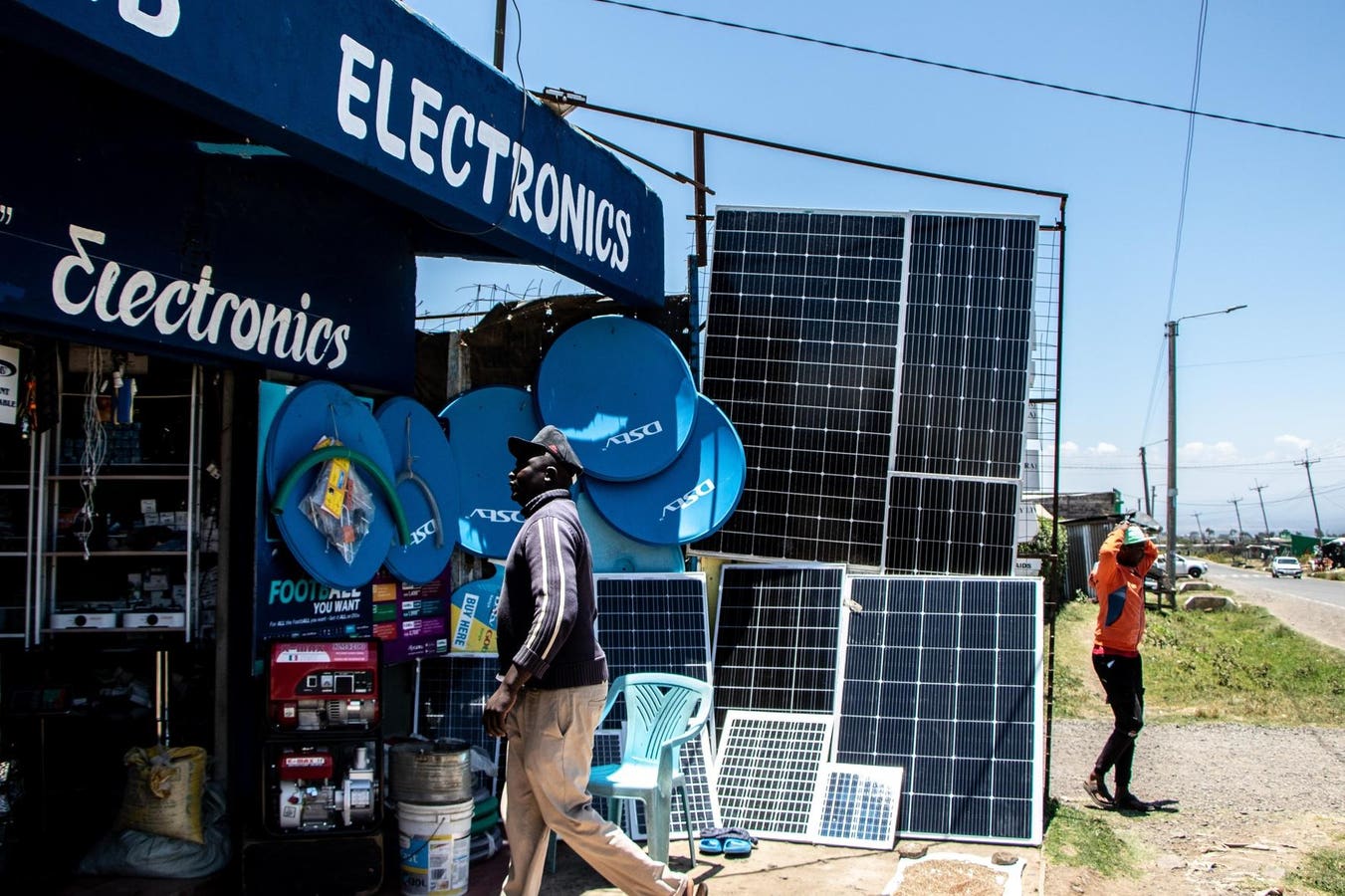Solar panels for sale near Nyeri, Kenya, in 2024. (Photo by James Wakibia)
When Rose Mutiso was growing up in Nairobi in the 1990s, her family kept candles and paraffin lamps at the ready. Power outages were common. Without electricity, her family couldn’t watch TV or do much of anything; there was a lot of sitting in the dark. She felt like she was living in a disaster zone.
But by the time Mutiso was in high school in the 2000s, this had ceased to be a worry. Blackouts were rare. She could take it for granted that she would be able to study after dinner.
“It’s completely night and day from how it was when we were younger,” marvels Mutiso, who is now the research director for the Energy for Growth Hub, an energy think tank.
The speed of the change was impressive indeed. It’s part of a larger shift that has transformed Kenya, especially urban Kenya, over the last few decades. Electricity access soared from 37% in 2013 to 79% in 2023, according to the latest Kenyan energy policy review prepared by the International Energy Agency (IEA) and the Kenyan government. (The IEA has defined electricity access as being able to power at least a handful of basic devices.)
This progress has extended to informal settlements, the unplanned areas where the lowest-income urbanites live. In one year, starting in May 2014, the national utility, Kenya Power, took a community-based approach to triple the number of slum households connected to electricity. Access remains unequal, but now almost everybody living in an informal settlement has access to an electricity connection, raising the overall urban access rate to nearly 100%. It’s a remarkable shift from 2010, when urban homes were even less connected to electricity than rural ones on average, largely because of the lacking provision in informal settlements.
Progress is pushing forward. The Kenyan government is aiming to reach 100% electricity access by 2030 and 100% renewable electricity generation by 2035; the latter goal has been applauded for climate leadership. However, the next push may be the hardest one yet.
A Difficult Time For Energy Globally
The world definitely needs a win on energy. There’s been plenty of disturbing news lately about energy belligerence and blackouts, for instance.
Globally, we have an ambitious energy objective in Sustainable Development Goal (SDG) 7. Among other things, this SDG seeks to ensure universal access to energy and to double the rate of improvement in energy efficiency by 2030.
Progress has been uneven. While the gap between rural and urban electrification has narrowed worldwide, neither is universal, outside of North America and Europe. As of 2022, 73% of people had access to clean cooking, with Oceania and sub-Saharan Africa most deprived. More positively, the share of renewable energy in sub-Saharan Africa’s energy mix soared by 69% between 1990 and 2021, more than twice as fast as in any other region.
Overall, Mutiso is blunt in her assessment: “We’re definitely not going to meet the 2030 SDG 7 goal. So this [Kenya’s progress] is a bright spot.”
Steam rises from a vent at the Olkaria Geothermal Power Station in the Hell’s Gate National Park, in … More
How Kenya Dramatically Increased Energy Access
One big advantage with renewable electrification has been Kenya’s natural resources. “Kenya just has a sweetheart resource endowment,” Mutiso puts it. Geothermal, hydro, wind, and solar power generate nearly 90% of the electricity.
A vibrant market for off-grid solar energy has played a big role in energy expansion, Mutiso says. Kenya is the world’s biggest market for off-grid solar. Much of this comes down to the entry-level products that move people out of extreme energy poverty, such as solar fans. While many off-grid products are imported from China, there is some local assembly, as well as a lot of financial innovation from Kenyan companies. For instance, pay-as-you-go credit has allowed many consumers to own electrical appliances for the first time.
Mutiso lauds the collaboration among government agencies and partners that has led to this achievement, from grids to off-grid solar. “The government has had this really coordinated, multi-prong strategy from the top.”
This has included attention to gender inequalities. The Last Mile Connectivity Project (LMCP) prioritized connections for public facilities and homes relatively close to existing transformers, as well as areas with many households headed by women. The project also aims for at least 30% of construction-phase jobs to go to women. There have been separate projects with solar systems to power electric cooking, including in Kenya’s refugee camps, which have particularly helped women and their families move away from polluting fuel sources.
Kenya is already home to Africa’s largest wind farm. And Kenya has not yet peaked on solar and wind generation, according to Alex Wachira, the principal secretary of Kenya’s State Department for Energy. The government wants to increase battery storage and offshore wind energy, among other things. There is also potential to expand geothermal power, which is low-cost and already makes up the largest chunk of Kenya’s electricity.
Remaining Challenges
However, the good news shouldn’t obscure the significant gaps. A pressing one is the persistence of polluting fuels for cooking. There has been some advancement here, but not nearly enough. In 2013 only 10% of households had access to clean cooking fuels; in 2023, 31% did. Most of the country remains dependent on burning fuel sources like wood. Especially affected are women and girls, who breathe in the bulk of indoor air pollution, and are mainly tasked with the time-consuming work of collecting wood and monitoring pots cooking over flames.
There’s room to improve the image (and the supply chain) of electric cooking appliances. Low-quality or counterfeit imports have been an issue. And Beryl Onjala, a research associate at the small energy company Gamos East Africa, says that many Kenyans still associate eCooking as a whole with the hot plates that used to come bundled with their liquefied petroleum gas (LPG) stoves. Indeed hot plates consume a lot of electricity. “A lot of us have not yet interacted with the energy-efficient options,” which Onjala says work out much cheaper than traditional sources like firewood. There are ongoing awareness campaigns to spread information about energy-efficient appliances and how to cook with them, though the messaging has not yet penetrated everywhere.
There’s good news here too, in that people working on clean cooking know what needs to be done, Onjala says. Her organization contributed to the Kenya National Cooking Transition Strategy, a roadmap for the 2024–2028 period that is the first of its kind in Africa. The hard part is ensuring the resources and attention to actually implement the plans.
Coffee farmer Josphat Muchiri lights his biogas burner, in Kiambu, Kenya. (Photo by Tony Karumba)
With electrification in general, Mutiso warns, “the very last mile is always the hardest. I think getting to 80% is going to be easier than getting to 90%.” After tackling low-hanging fruit, like urban connections, “It’s not proportional. The problem gets harder as you get to the edges.” Energy for industries is an even bigger problem than residential energy, according to Mutiso. She says that energy rates need to be designed very carefully in order to protect low-income consumers while keeping heavy and industrial consumers happy, since they can offset costs for others. But Wachira emphasizes from the government side, “We are not keen on subsidizing consumption.”
Major issues across the country are reliability and cost. Kenya has some of the highest electricity prices in Africa. Both appliances and electric supply remain unaffordable to many. High energy costs overall are due to a number of factors, including inefficiencies, losses, theft, inflation, and quirks of long-term contracts that result in the utility paying for more expensive power sources even when cheaper ones are available.
As for reliability, electricity networks had losses of about 23% in 2023. One response to instability within the Kenyan grid has been to increase imports of energy from Ethiopia, Uganda, and Tanzania. Even with the high costs, power outages persist. Onjala herself has a backup LPG stove, though she mainly relies on her electric pressure cooker and induction burner.
For cooking fuels, Wachira says, Kenya is aiming to increase the sources of biofuel, and to lower the prices of LPG. Measures include scrapping the value-added tax (VAT) on LPG, though the VAT on LPG-using cookstoves remains. LPG, a byproduct of fossil fuel processing, is an imperfect solution. Many consider LPG “a transition fuel on the way to electric cooking,” Onjala comments.
In general, she says of energy-efficient cooking appliances, “the government treats it mostly as a luxury good.” Reclassifying these appliances would lower the VAT charged on them. Work is also ongoing to explore a specific electricity rate that would apply to eCooking for households, companies, and public institutions.
Any such measures are within the context of “improving the economic situation of the country” as a whole, Wachira comments, which will help with affordability. That economic situation is challenging. Kenya’s economic growth slowed in 2024 amidst floods and anti-government protests.
Though the off-grid sector has grown and innovated enormously, Mutiso says that it’s still struggling with profitability. For extremely poor people, donor funds is still needed. Yet the U.S. and Europe have been slashing their foreign assistance in recent months, massively disrupting basic Kenyan services.
Added to this are the shockwaves from U.S. trade policy. Kenya’s ambitious goals for green industrialization depend on global supply chains and financial markets for infrastructure investments, Mutiso notes. There were already huge barriers to affordable capital, for instance with credit agencies overstating the risk profiles of African countries, which has raised the cost of borrowing and contributed to debt distress. On top of these longer-term trends, Mutiso worries, “if we’re seeing a global trade war escalating, if we’re seeing a possible global recession, this is bad news.”
As wealthy countries reconsider their responsibilities when it comes to international development, and as international investors continue to look at Kenya, people like Mutiso are urging a focus on infrastructure. The Kenyan government has an energy transition and investment plan that looks ahead to 2050, and which calls for US$ 600 billion in investments, mainly in power and transport.
“If we wait for domestic sources [of financing], we may not be able to” bring electricity to the millions of Kenyans who still lack it, Wachira says. And as the population continues to grow, energy supply needs to keep pace. “It requires a lot of financing, it requires a lot of partners.” Many investors are interested, according to Wachira. What the country needs from the private sector is concessional finance. But if financing comes at a higher cost, he warns, “we may not be able to accept the private capital.”








